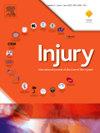Time to surgery and other risk factors for mortality and complication rates in patients with periprosthetic femoral fractures at the knee
IF 2.2
3区 医学
Q3 CRITICAL CARE MEDICINE
Injury-International Journal of the Care of the Injured
Pub Date : 2025-02-01
DOI:10.1016/j.injury.2024.112071
引用次数: 0
Abstract
Background
There is a high level of evidence that a short time to surgery (TTS) improves the outcome for patients with hip fractures. Accordingly, recommendations for timely treatment have been included in national guidelines. As patient characteristics appear to be similar, it seems reasonable that these guidelines are applicable to other fracture entities, such as knee periprosthetic femoral fracture (PPF). This monocentric retrospective study aimed to investigate outcome-related risk factors, particularly TTS, for knee PPF.
Methods
In total, 141 consecutive patients with knee PPF in a maximum-care arthroplasty and trauma centre, treated between 2006 and 2020, were retrospectively evaluated. Primary outcome variables were operative and general complications as well as mortalities within 1 year. Outcome-related risk factors were identified based on regression analysis using SPSS. For analysis of TTS, the cases were divided into two groups using a TTS of 24 h as the cutoff value.
Results
The 1-year mortality was 8.3 %. Associated risk factors were age (HR 1.2; p = 0.010) and Charlson score (HR 2.1; p = 0.001). Both, surgical and general complications occurred in 20.6 % of the cases. Age (OR 1.07, p = 0.025) and a TTS > 24 h (OR 3.06, p = 0.020) were identified as risk factors for general complications. The TTS ≤ 24 h (n = 75) and TTS > 24 h (n = 66) groups were comparable in terms of baseline characteristics. Revision arthroplasty was performed more frequently in the TTS > 24 h group (p < 0.001).
Conclusion
1-year mortality after knee PPF was 8.3 %. With a high complication rate in the treatment of knee PPF, TTS was identified as a risk factor for general complications. Early treatment appears to be beneficial for patients with knee PPF.
手术时间和其他危险因素对膝关节假体周围股骨骨折患者死亡率和并发症发生率的影响。
背景:有高水平的证据表明,短时间手术(TTS)可以改善髋部骨折患者的预后。因此,关于及时治疗的建议已列入国家准则。由于患者特征相似,这些指南适用于其他骨折实体,如膝关节假体周围股骨骨折(PPF)似乎是合理的。这项单中心回顾性研究旨在调查结果相关的危险因素,特别是TTS,膝关节PPF。方法:对2006年至2020年期间在最高护理关节置换术和创伤中心治疗的141例连续膝关节PPF患者进行回顾性评估。主要结局变量为手术和一般并发症以及1年内的死亡率。采用SPSS进行回归分析,确定与预后相关的危险因素。为了分析TTS,将病例分为两组,以24 h的TTS为截止值。结果:1年死亡率为8.3%。相关危险因素为年龄(HR 1.2;p = 0.010)和Charlson评分(HR 2.1;P = 0.001)。手术和一般并发症发生率均为20.6%。年龄(OR 1.07, p = 0.025)和TTS bb0 24 h (OR 3.06, p = 0.020)是一般并发症的危险因素。TTS≤24 h组(n = 75)和TTS≤24 h组(n = 66)在基线特征方面具有可比性。TTS组在24小时内更频繁地进行翻修关节置换术(p < 0.001)。结论:膝关节PPF术后1年死亡率为8.3%。由于膝关节PPF治疗的并发症发生率高,TTS被认为是一般并发症的危险因素。早期治疗似乎对膝关节PPF患者有益。
本文章由计算机程序翻译,如有差异,请以英文原文为准。
求助全文
约1分钟内获得全文
求助全文
来源期刊
CiteScore
4.00
自引率
8.00%
发文量
699
审稿时长
96 days
期刊介绍:
Injury was founded in 1969 and is an international journal dealing with all aspects of trauma care and accident surgery. Our primary aim is to facilitate the exchange of ideas, techniques and information among all members of the trauma team.

 求助内容:
求助内容: 应助结果提醒方式:
应助结果提醒方式:


